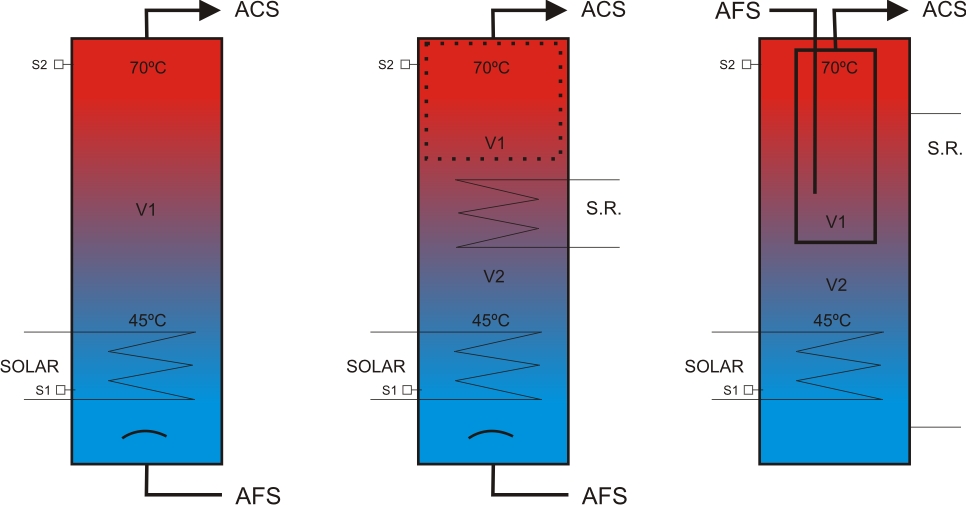Accumulator is responsible for storing the thermal energy generated by the solar collectors.
It is essential in solar systems since periods of solar radiation and energy transfer do not usually correspond to periods in which hot water consumption takes place.
Storing energy using hot water is cheap, easy to handle, has a high heat capacity and is at the same time the consumption element in case of DHW (domestic hot water).
Accumulator type depends on the application: domestic hot water, air conditioning, heating or industrial use.

Most common are:
– Domestic hot water accumulators: they must be able to withstand high levels of pressure and expected working temperatures, not suffer deterioration due to corrosion phenomena and compulsorily comply with requirements for storing drinking water.
They are generally offered with capacities of 100 to 5,000 liters of accumulation.
– Inertia accumulators: they are used as a heat accumulator for heating systems or for large DHW installations. They fulfill the function of buffer for heat or cold storage. They act as hydraulic memory between heat production and release.
They are generally offered with capacities of 500 to 5,000 liters of accumulation.
– Combined accumulators: they combine accumulation of DHW and accumulation of heating.
In the same accumulator, for example, 175 liters of DHW accumulation and 600 liters of heating accumulation are combined.
They are generally offered with capacities from 175 to 250 liters for DHW accumulation and 500 to 2,000 liters for heating accumulation.
The most used materials accumulators’ construction are:
– Steel: it needs internal treatments based on epoxy or vitrified to avoid corrosion.
– Stainless steel: it is without a doubt the best material.
– Galvanized steel: accumulation temperature must not exceed 65º C.
– Reinforced fiberglass: resists corrosion, weighs little and is easy to maintain, but withstands low temperatures (60º C maximum).
– Plastics: it has similar qualities to fiberglass.
– Aluminum: it is not advisable due to corrosion problems.
In addition to interior treatments, accumulators incorporate corrosion protection devices.
One of the problems caused by corrosion is that rust and sediments favor the legionella development.
It is essential to avoid it by building accumulators with noble materials such as some type of stainless steel and / or combination of some inner lining and a cathodic protection system.
Accumulators are usually cylindrical in shape and have a vertical dimension greater than horizontal one to favor thermal stratification of the inside water.
Hottest water from top will be located in the extraction zone towards consumption or towards conventional support system. Coldest water is in the lower part of the tank, which will be from where it will be pushed towards solar collectors.
In this way, we operate the collectors at the minimum possible temperature, increasing their performance.

Accumulation volume size depends mainly on three factors:
1 • Installed collectors surface
As a general criterion for DHW, an accumulation volume between 50-100 liters per m2 of solar collector is recommended.
Higher values do not lead to a significant increase in solar energy use, and accumulator cost increases.
In contrast, smaller sizes increase the temperature, thus decreasing collectors’ efficiency.
For small DHW systems production, solar tank capacity should be equal to daily hot water consumption.
2 • Operating temperature
This will determine type of stratification device, as well as insulator thickness to be used, depending on maximum losses that are admissible considered.
3 • Offset between collection – storage and consumption
Accumulation volume will be a function of lag between collection – storage and consumption period, which can be:
* Coincidence between collection period and consumption period (case of preheating a boiler in a continuous process).
In this case, accumulator specific volume will be 35-40 liters / m2.
* Offsets between collection and consumption not exceeding 24 hours (heating of sanitary water in multi-family homes, hotels, etc.).
In this case, volume will be 60-90 liters / m2.
* Offset between usual and periodic collection and consumption for more than 24 hours and less than 72 hours (heating of domestic hot water in industrial processes, etc.).
In this case, volume will be 75-100 liters / m2.
* Offsets between collection and consumption greater than 72 hours (heating of sanitary water in second home, on weekends.).
In this case, volume will be determined by balancing energy losses and gains and insulation optimizing.
This content was extracted from the Solar Thermal Energy Technical-Commercial Manual and is part of Solar e-learning.
All you need is Sun. All you need is Sopelia.
